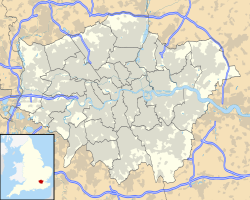St Katharine Docks
Location of St Katharine Docks in Greater London |
The St Katharine Docks in the London Borough of Tower Hamlets were one of London's trading ports on the north bank of the Thames just east of Tower and Tower Bridge . They were part of the Port of London , were in what is now Docklands, and are now a popular residential and entertainment district. This transformation is seen as a model or negative example of gentrification .
history
The St Katharine Docks are named after the former St Katharine's by the Tower hospital , which was built in the 12th century and stood in its place. A densely built-up area of 9.5 hectares, the Precinct of St Katharine , was reserved for change of use by parliamentary resolution of 1825; work began in May 1827. About 1,250 houses and St Katharine's medieval hospital were demolished. 11,300 residents, mostly dock workers, who lived in cramped conditions there, lost their homes. Only the landowners received compensation. The work was planned by civil engineer Thomas Telford ; it was his only big project in London. In order to create as many anchorages as possible, the port facilities were planned in the form of two connected basins (east and west), both of which received an access lock from the Thames. Steam engines built by James Watt and Matthew Boulton kept the water level in the basins about 1 m above that of the tidal river.
Telford's goal was to keep port work to a minimum, and so he planned the warehouses right on the quays so that the goods could be carried from the ships directly into the warehouses designed by architect Philip Hardwick .
The port facilities were officially opened on October 25, 1828. Although they were used frequently, they did not have great economic success, as large ships could not anchor in them. In 1864 they were merged with the London Docks . In 1909 the Port of London Authority took over the management of almost all port facilities on the Thames, including that of St Katharine.
During the Second World War , the St Katharine Docks were badly damaged by German bombs and were never completely rebuilt. Because of their very limited capacity, especially for large, modern ships, they were among the first port facilities to be closed in 1968. The site was sold to the Greater London Council . Most of the original warehouses were demolished and replaced with modern commercial buildings in the 1970s. The port facilities themselves became marinas. This conversion was often cited as a successful example of urban redevelopment.
There were plans to build underground stations near St Katharine Docks on the proposed Fleet Line . They would have been called Fenchurch Street and Wapping . An eastern extension was later built as part of the Jubilee Line , but on a different route south of the Thames. The closest underground station to the port facilities is Tower Hill . Wapping has been closed for renovation for the London Overground .
St Katharine Docks today
The site now has commercial buildings, public and private housing developments, a large hotel, shops and restaurants, and a pub (the Dickens Inn , a former brewery from the 18th century). A marina and a recreation area were created. This makes the area a popular entertainment district.
The eastern harbor basin is now dominated by the City Quay residential complex, in which there are over 200 luxury apartments with a view of the marina. The southern part of the eastern harbor basin is surrounded by the South Quay Estate - originally a council estate .
Known residents
- Ruth Kelly , Secretary of State for Local Services
- David Mellor , television presenter and former politician
St Katharine Pier
The St Katherine Pier is located near the St Katherine Docks and serves as the landing stage for the ships of the London River Services . The most important connections include a river cruise operated by Crown River Cruises , which runs non-stop to Westminster Millennium Pier and back with a stop at the South Bank Art Gallery, and a Westminster-Greenwich express connection operated by Thames River Services .
The nearby Tower Millennium Pier on the other side of Tower Bridge is now responsible for the main shipping traffic to Canary Wharf and Greenwich , the East End and West End, as well as a fast connection to the London Eye .
Web links
- St Katharine Docks
- TFT Cultural Heritage for St Katharine's Investments LP St Katharine Docks Conservation Plan , 2005
Individual evidence
- ↑ Boats from St Katharine's Pier , Transport for London (2008) (PDF; 105 kB)
- ↑ Boats from Tower Millennium Pier , Transport for London (2008) (PDF; 142 kB)





